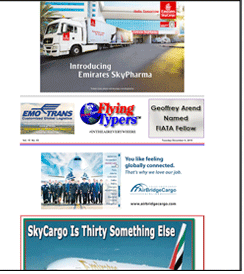

#INTHEAIREVERYWHERE
 |
 #INTHEAIREVERYWHERE |
| Vol. 16 No. 1 | Monday
January 2, 2017 |
| 2016 Year of Dubious Distinction |

The air freight demand picture brightened significantly in the latter part of 2016, and trade forecasts are positive. But leading airlines contacted by FlyingTypers are plotting a cautious strategy for the New Year. By The Numbers Nomura’s
index of Asia exports (excluding Japan) recently
leapt to its highest level since February 2015,
promising a return to positive single-digit export
growth in early 2017. The index comprises eight
forward-looking components and has a three-month
lead-time over actual Asia exports, so it bodes
well for the air freight industry over the next
quarter. Upsurge Drives Trade The figures illustrate the upsurge in trade to and from Asia, which is also supported by many of the world’s leading airlines and analysts contacted by FlyingTypers. “Airlines reported continued strong growth in November 2016, in line with the increase we saw in October,” WorldACD told FlyingTypers. “Most regions performed well in November. Especially air cargo volume from Africa, which showed strong year-on-year growth.” Lufhtansa Comes Back Andreas
Pauker, spokesman for Lufthansa Cargo, confirmed
a return to the traditional peak season in late
2016 and pointed to air cargo shipments from Asia
to Europe and the U.S. as fast improving lanes,
while key growth sectors included garments, automotive,
and high tech products, components, and shipments
driven by the e-commerce sector. Kerr Concurs, Looks For More
Look Ahead 2017
Looking forward to 2017, airlines are more cautious
than the air freight forwarder counterparts recently
surveyed by FlyingTypers. |
If
You Missed Any Of The Previous 3 Issues Of FlyingTypers Access complete issue by clicking on issue icon or Access specific articles by clicking on article title |
||
 Vol.
15 No. 93 Vol.
15 No. 93SkyCargo Is Thirty Something Else Babar Of Pakistan Chuckles For December 6, 2016 41 Years Of Vital Views The Swan Of Tuonela |
 Vol.
15 No. 94 Vol.
15 No. 94Year End 2016, Outlook for 2017 Chuckles for December 15, 2016 |
|
Publisher-Geoffrey
Arend • Managing Editor-Flossie Arend • Film Editor-Ralph Arend • Special Assignments-Sabiha Arend, Emily Arend • Advertising Sales-Judy Miller |
|